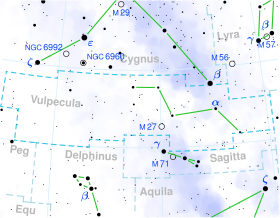
| |
| Observation data Epoch J2000 Equinox J2000 | |
|---|---|
| Constellation | Vulpecula |
| 13 Vulpeculae A | |
| Right ascension | 19 53 27.6957 |
| Declination | 24° 04′ 46.608″ |
| Apparent magnitude (V) | 4.584±0.008 |
| 13 Vulpeculae B | |
| Right ascension | 19 53 27.6102 |
| Declination | 24° 04′ 46.077″ |
| Characteristics | |
| Spectral type | B9.5III |
| Apparent magnitude (U) | 4.404±0.012 |
| Apparent magnitude (B) | 4.536±0.010 |
| Astrometry | |
| 13 Vulpeculae A | |
| Radial velocity (Rv) | −28.10 km/s |
| Proper motion (μ) | RA: 22.325±0.065 mas/yr Dec.: 36.510±0.072 mas/yr |
| Parallax (π) | 9.6342 ± 0.0902 mas |
| Distance | 339 ± 3 ly (103.8 ± 1.0 pc) |
| Absolute magnitude (MV) | −0.48 |
| 13 Vulpeculae B | |
| Proper motion (μ) | RA: 14.037±0.135 mas/yr Dec.: 32.954±0.131 mas/yr |
| Parallax (π) | 9.8828 ± 0.1524 mas |
| Distance | 330 ± 5 ly (101 ± 2 pc) |
| Orbit | |
| Period (P) | 615.25±104.12 yr |
| Semi-major axis (a) | 1.555±0.241″ |
| Eccentricity (e) | 0.079±0.042 |
| Inclination (i) | 85.9±1.5° |
| Longitude of the node (Ω) | 68.1±0.3° |
| Periastron epoch (T) | 2027.82±94.79 |
| Argument of periastron (ω) (secondary) | 169.7±4.4° |
| Details | |
| 13 Vul A | |
| Radius | 1.3 R☉ |
| Luminosity | 180 L☉ |
| Temperature | 8,801 K |
| Metallicity | −0.11 dex |
| Rotational velocity (v sin i) | 45.0 km/s |
| Other designations | |
| 13 Vul, BD+23°3820, GC 27544, HD 188260, HIP 97886, HR 7592, SAO 87883, CCDM J19535+2405AB, WDS J19535+2405AB, 2MASS J19532768+2404464 | |
| Database references | |
| SIMBAD | data |
13 Vulpeculae is a blue giant with a stellar classification of class B9.5III in the northern constellation Vulpecula. It is visible to the naked eye as a faint, blue-white hued star with an apparent visual magnitude of 4.57 and it is approximately 339 light years away from the Sun based on parallax. The star is radiating 180 times the luminosity of the Sun from its photosphere at an effective temperature of 8,801 K.
There is one reported companion, designated component B, with a magnitude of 7.37, an orbital period of roughly 615 years, and an angular separation of 1.55″. The system is moving closer to the Earth with a heliocentric radial velocity of −28 km/s.
References
- ^ Brown, A. G. A.; et al. (Gaia collaboration) (2021). "Gaia Early Data Release 3: Summary of the contents and survey properties". Astronomy & Astrophysics. 649: A1. arXiv:2012.01533. Bibcode:2021A&A...649A...1G. doi:10.1051/0004-6361/202039657. S2CID 227254300. (Erratum: doi:10.1051/0004-6361/202039657e). Gaia EDR3 record for this source at VizieR.
- ^ Harmanec, P.; et al. (2020). "A new study of the spectroscopic binary 7 Vul with a Be star primary". Astronomy and Astrophysics. 639. Table A.1. arXiv:2005.11089. Bibcode:2020A&A...639A..32H. doi:10.1051/0004-6361/202037964. S2CID 218862853.
- ^ Brown, A. G. A.; et al. (Gaia collaboration) (2021). "Gaia Early Data Release 3: Summary of the contents and survey properties". Astronomy & Astrophysics. 649: A1. arXiv:2012.01533. Bibcode:2021A&A...649A...1G. doi:10.1051/0004-6361/202039657. S2CID 227254300. (Erratum: doi:10.1051/0004-6361/202039657e). Gaia EDR3 record for this source at VizieR.
- ^ Anderson, E.; Francis, Ch. (2012). "XHIP: An extended hipparcos compilation". Astronomy Letters. 38 (5): 331. arXiv:1108.4971. Bibcode:2012AstL...38..331A. doi:10.1134/S1063773712050015. S2CID 119257644. Vizier catalog entry
- ^ Gontcharov, G. A. (2006). "Pulkovo Compilation of Radial Velocities for 35 495 Hipparcos stars in a common system". Astronomy Letters. 32 (11): 759–771. arXiv:1606.08053. Bibcode:2006AstL...32..759G. doi:10.1134/S1063773706110065. S2CID 119231169.
- Hartkopf, W. I.; et al. (June 30, 2006), Sixth Catalog of Orbits of Visual Binary Stars, United States Naval Observatory, archived from the original on 2017-08-01, retrieved 2017-06-02.
- Pasinetti Fracassini, L. E.; et al. (February 2001). "Catalogue of Apparent Diameters and Absolute Radii of Stars (CADARS)". Astronomy and Astrophysics. 367 (2) (Third ed.): 521–524. arXiv:astro-ph/0012289. Bibcode:2001A&A...367..521P. doi:10.1051/0004-6361:20000451. S2CID 425754.
- ^ McDonald, I.; Zijlstra, A. A.; Boyer, M. L. (2012). "Fundamental parameters and infrared excesses of Hipparcos stars". Monthly Notices of the Royal Astronomical Society. 427 (1): 343–357. arXiv:1208.2037. Bibcode:2012MNRAS.427..343M. doi:10.1111/j.1365-2966.2012.21873.x. S2CID 118665352. Vizier catalog entry
- Glebocki, R.; Gnacinski, P. (2005). "VizieR Online Data Catalog: Catalog of Stellar Rotational Velocities (Glebocki+ 2005)". VizieR On-line Data Catalog: III/244. Originally Published in: 2005csss...13..571G; 2005yCat.3244....0G. 3244. Bibcode:2005yCat.3244....0G. Vizier catalog entry
- "13 Vul". SIMBAD. Centre de données astronomiques de Strasbourg. Retrieved 2019-03-15.
- Malkov, O. Yu.; Tamazian, V. S.; Docobo, J. A.; Chulkov, D. A. (2012). "Dynamical masses of a selected sample of orbital binaries". Astronomy & Astrophysics. 546: A69. Bibcode:2012A&A...546A..69M. doi:10.1051/0004-6361/201219774. Vizier catalog entry
External links
- 13 Vulpeculae on WikiSky: DSS2, SDSS, GALEX, IRAS, Hydrogen α, X-Ray, Astrophoto, Sky Map, Articles and images
| Constellation of Vulpecula | |||||||||||||
|---|---|---|---|---|---|---|---|---|---|---|---|---|---|
| Stars |
| ||||||||||||
| |||||||||||||
| |||||||||||||
| |||||||||||||
| Galaxies |
| ||||||||||||
| |||||||||||||